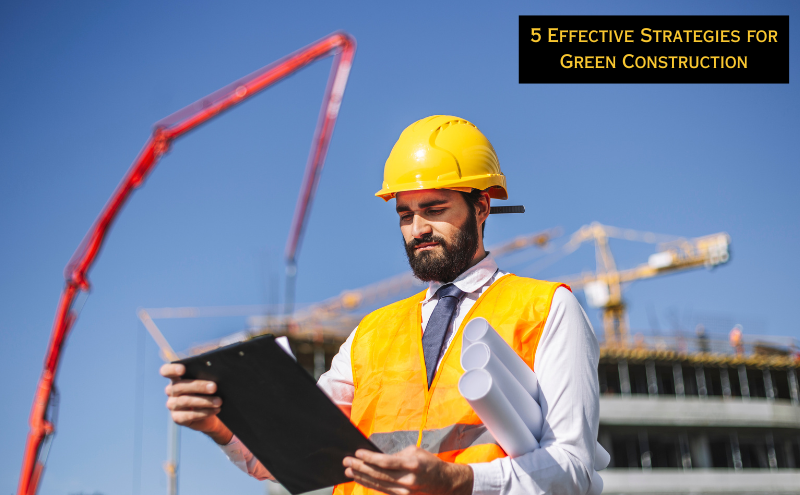
As the global environmental impact continues to grow, construction companies are recognizing the need to reduce their resource consumption and adopt greener practices. While this transition may take time, it is crucial for the future well-being of our planet. In this article, we will explore five effective strategies that construction companies can implement to build green and create more sustainable projects.
Monitor Fuel Consumption
It is important for construction companies to monitor the fuel consumption of their tools and equipment. The burning of fossil fuels, such as oil and gas, is a major contributor to climate change. By switching to electric vehicles and transitioning to more sustainable power sources, construction companies can significantly reduce their carbon footprint. Many manufacturers now offer electric and hybrid options for heavy machinery, making it easier to embrace greener alternatives.
Additionally, implementing a fleet monitoring system can help track the fuel consumption of each vehicle. This not only improves vehicle security but also enables companies to identify units that consume the most fuel. By reducing the usage of these vehicles or replacing them with electric alternatives, construction sites can achieve significant fuel savings.
Cut Back on Paper Usage
Construction companies should aim to minimize their paper usage, particularly for project management purposes. While important legal documents may still require printing, there are numerous online tools and cloud-based project management software available that can replace the need for paper in day-to-day operations. These tools enable efficient scheduling, cost calculation, risk assessments, and progress tracking, among other essential project management tasks.
By embracing digital solutions, construction companies can involve their staff more closely in the planning process, making their jobs easier and allowing everyone to contribute to environmentally beneficial solutions. This not only reduces paper waste but also streamlines operations and enhances collaboration among team members.
Use Eco-Friendly Building Materials
Choosing eco-friendly building materials is a fundamental aspect of green construction. Instead of relying on cheap artificial goods like plastic and drywall, construction companies should switch to more sustainable alternatives. Wood and stone, for example, are practical and cost-effective solutions that offer durability and visual appeal.
To further enhance sustainability, construction companies can explore the use of eco-friendly materials like concrete made from organic ingredients. Additionally, there are several naturally-occurring materials that can be used, including masonry, cork, bamboo, adobe brick, straw bale, and cordwood. Even smaller-scale products like paint and insulation have green alternatives that conserve energy and contain fewer harmful chemicals. By prioritizing the use of eco-friendly materials throughout the construction process, companies can create buildings that align with sustainability goals.
Dispose of Waste Properly
Construction projects generate a significant amount of waste, including drywall, shingles, lumber, and other materials. Instead of simply sending these materials to landfills, construction companies should find better waste disposal solutions. Recycling facilities should be used to dispose of glass, plastic, and metal, while materials with remaining value should be repurposed or reused.
Many organic materials from construction sites have alternative uses. For example, lumber can be converted into mulch, and excess masonry can be utilized in other projects. Metal objects can be smelted and transformed into entirely new products. Embracing a mindset of waste reduction and resource optimization can significantly minimize waste generation and contribute to a circular economy.
It is also important to address sedimentary runoff, which can lead to water pollution and soil erosion. By setting up silt fences around construction sites, hazardous materials can be prevented from entering local water sources and ecosystems, reducing pollution and soil erosion.
Work With Like-Minded Partners
Collaborating with subcontractors and tradespeople who share a commitment to sustainable construction is essential in driving change within the industry. By forming partnerships with like-minded professionals, construction companies can develop comprehensive solutions to address sustainability challenges on their sites.
Sometimes, a bit of peer pressure is required to persuade stubborn companies to update their business practices. When other companies see their peers actively adopting green practices, they are more likely to follow suit. By encouraging open and honest discussions about sustainability among staff members, construction companies can foster a culture of environmental consciousness. This culture can lead to a network of like-minded business partners referring jobs to each other and contributing to the betterment of the community.
Conclusion
Building for the future means shifting our focus from efficient structures to energy-efficient structures that give back to the community and create a more harmonious world for future generations. By monitoring fuel consumption, cutting back on paper usage, using eco-friendly building materials, disposing of waste responsibly, and collaborating with like-minded partners, construction companies can create projects that have a lasting positive impact.
It is time to stop building solely for the present and start building for the future. By implementing these strategies, construction companies can contribute to a more sustainable world and ensure the well-being of both our planet and future generations.


